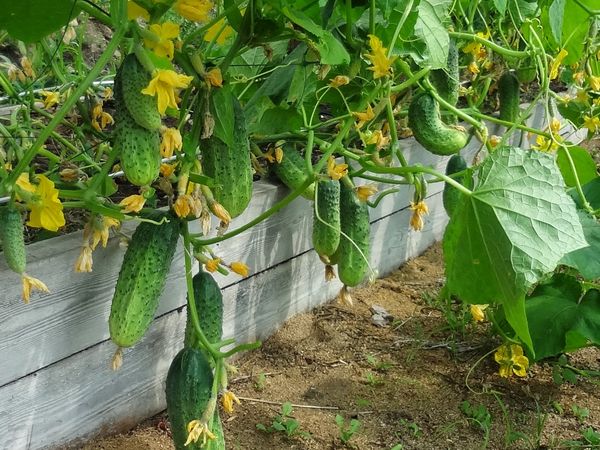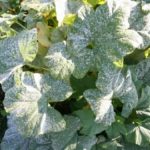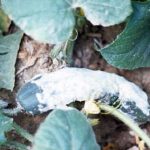Cucumbers are one of the most popular crops grown on personal plots and farms. Each gardener has in the arsenal his own methods for planting cucumbers in open ground or a greenhouse, thanks to which he succeeds in obtaining high yields. But the main secret is still in compliance with the general rules of agricultural technology, which will be discussed in this article.
We consider the varieties that can be planted in the Urals or in the suburbs, tell you what is the correct depth to plant the seed, what to fertilize seedlings and how to feed the land in a polycarbonate greenhouse.
Table of contents
The right time to plant cucumbers in open ground
Planting seeds or seedlings begins from the second half of May until June 15. At this time, there is still a danger of night frosts or a decrease in temperature below 12 degrees, so beds need protection.
Construct it with polyethylene film or agrofibre. In the daytime, the plants are revealed to be enriched with oxygen and illuminated by sunlight, which are very important for normal vegetation.
As a rule, it takes 3-4 weeks from planting in spring to transplant.You should not keep young shoots in greenhouse conditions, it violates the rhythm of plant development, reduces the formation of ovaries.
Most popular varieties
For planting in the Urals
Voyage
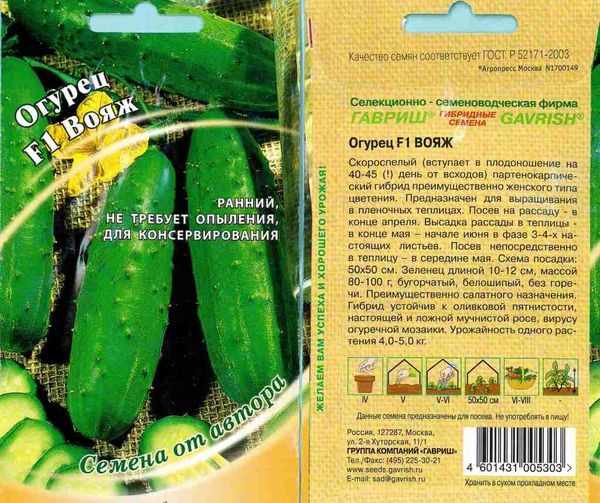
Parthenocarpic hybrid type with a growing period of 40-45 days. Fruits long up to 12 cm and weighing up to 110 grams They have excellent taste and high product qualities. The plant shows resistance to cladosporia, downy mildew, and cucumber mosaic.
Amur
Bee-pollinating early ripe hybrid Amurforming fruits by weight up to 118 gramslong up to 15 cm. The universal use and excellent taste have made the culture popular for application and planting in regions with difficult climatic conditions.
Features of Cupid: self-regulated branching, intensive fruit formation, long shelf life.
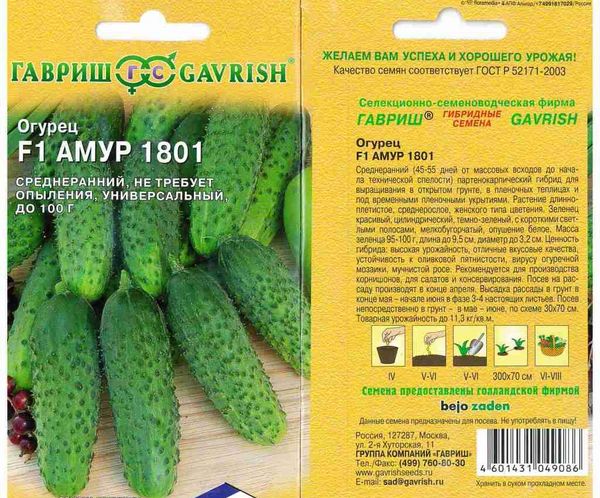
Arina
Cold-resistant plant with fruit length up to 17 cm. The hybrid shows resistance to downy mildew and cucumber mosaic. Type of flowering - mostly female.
The hybrid is characterized by a good development of lateral shoots, even if planted in low light conditions.
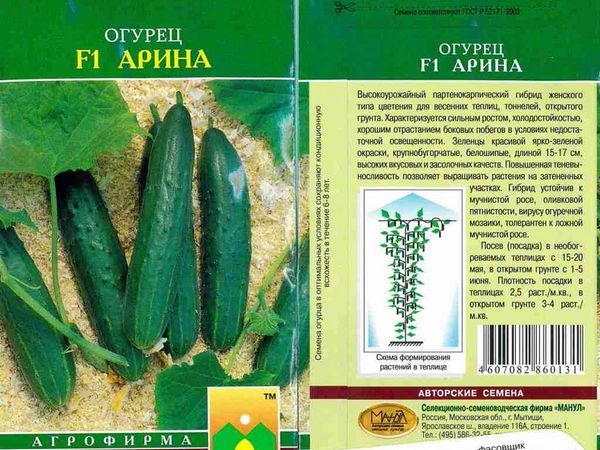
To land in the suburbs
April
Early ripe hybrid Aprilforming fruits by weight up to 200 grams. The length of the green leaves 15-25 cmtender flesh without bitterness taste. The peculiarity of the variety is the absence of yellowness on overripe vegetables. Tolerance to fungal diseases and spider mites is noted.
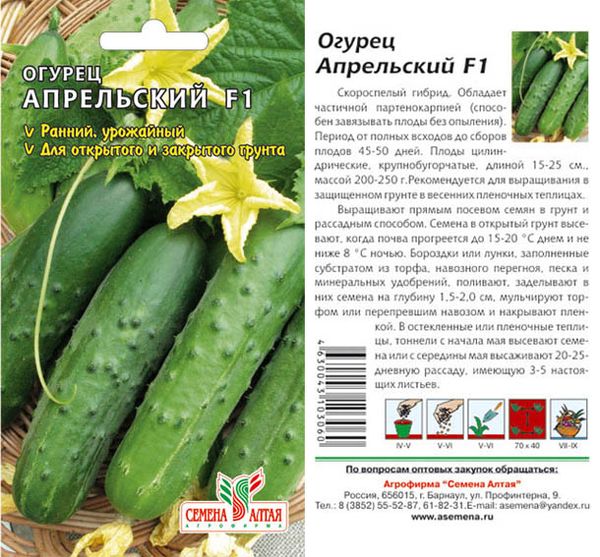
Business
The growing season lasts about 55 days. Zelentsy at maturity reach length 8-10 cm, weights - 100g. Scourge grows up to 1.8 m, is very branched. The culture is characterized by resistance to bacteriosis, downy mildew.
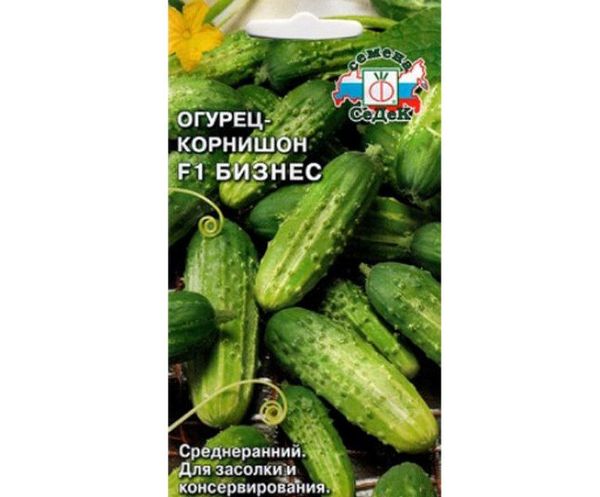
Aquarius
Ideal for salting cucumber, fruit length reaches 12-14 cm, weight - 100-120 grams. Harvesting can be planned in 35-45 days after germination of sprouts above the ground surface.
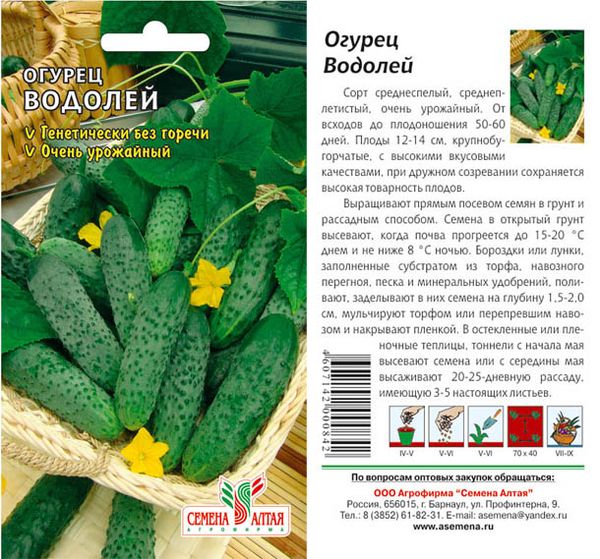
Cruise
Hybrid universal use with a growing season of 46-50 days. Fruits weighing on one whip 120-125 grams. The composition of greens is rich in ascorbic acid and sugar, which gives the taste of interesting notes. Vegetable suitable for fresh consumption and processed.
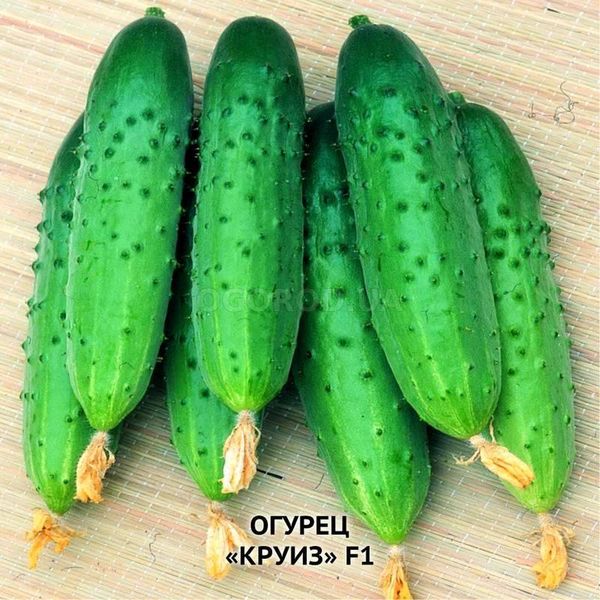
To plant in Ukraine
Steppe
The plant tolerates heat, so the hybrid is incredibly popular in southern Ukraine. The culture requires pollination, the ripening period allows you to start harvesting 45 days after the emergence of shoots. Fruit weight within 90-110 grams.
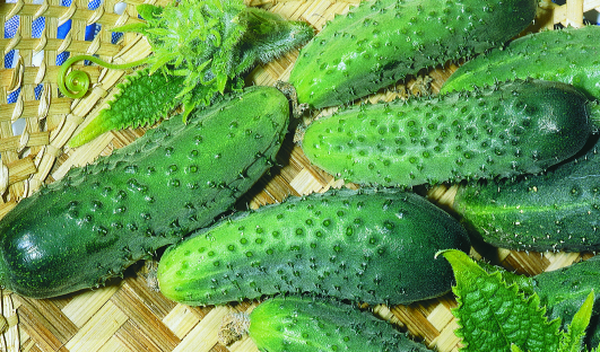
Nugget
Zelentsy ripen quickly, their sizes are small, but from the bush for the season can be removed 1.8 kg on average. Variety bee-pollinated, resistant to diseases and pests. Young shoots quickly adapt when transplanting to a new environment.
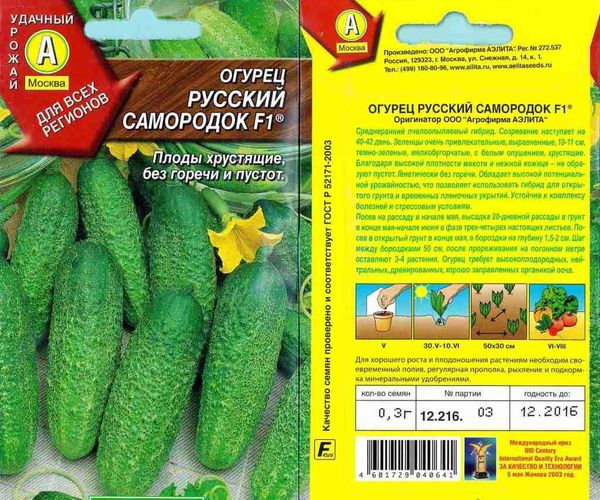
Nezhinsky
Nezhinsky - mid-season representative of cucumbers, giving generous yields. The Nezhinsky hybrid is tolerant to various diseases, shows resistance to temperature differences.
Fruits retain taste, even in pickled form. Zelentsov is harvested at 47-60 days after the sprout appears above the ground surface. With one lash off up to 1.2 kg of cucumbers.
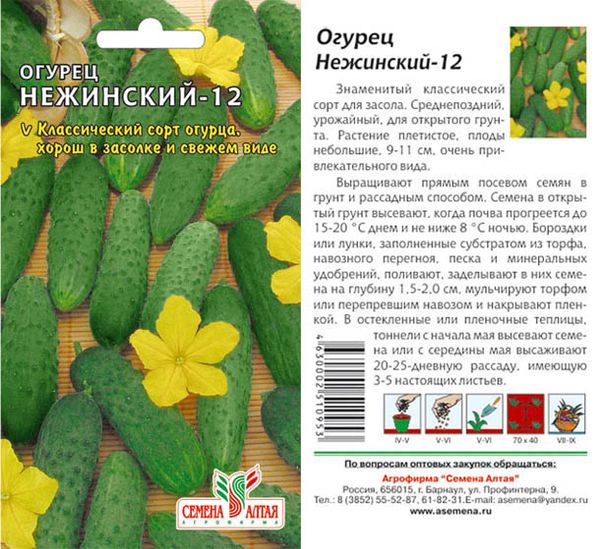
Pickling
Spreading whip does not need pinching, but the plant is quite demanding of moisture. For proper care gives the owners a generous harvest, and most importantly early. The growing season lasts only 35 days. Green weight reaches 120g at length 12-13 cm.
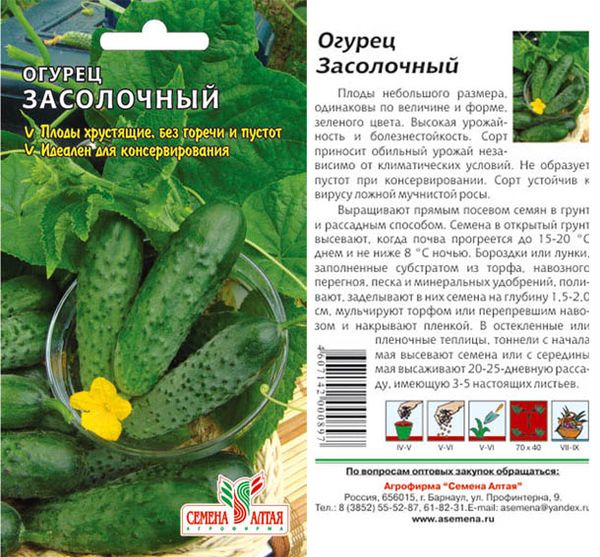
Rules of planting cucumbers in open ground and polycarbonate greenhouse
Planting cucumbers on the open beds is carried out after the establishment of the night temperature not below 10 degrees. If you sow a seed in a greenhouse or greenhouse - then the temperature conditions are softer.
Selection of seedlings for sowing in spring
If the seedlings are grown independently, then the dates of sowing the variety should be considered. Early varieties are planted in late March - early April. Mid-season and late Zelentsy sow on seedlings, starting from April 15.
When choosing a seedling on the market, the following factors should be taken into account:
- seedlings should not be older than 30-35 days;
- stem height reaches 25-30 cm;
- length of the perimeter knee does not exceed 5 cm, thickness is from 0.6 to 1 cm;
- white pimples (rudiments of roots) are seen on the subfamiliar knee;
- the number of sheets formed is 5-6, the diameter of the bottom reaches 16-20 cm.
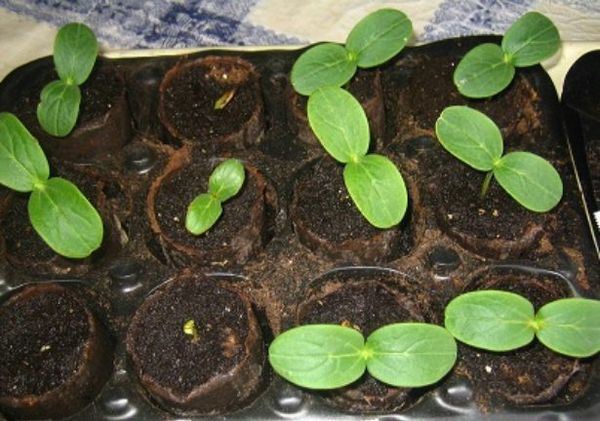
The root system of cucumbers is poorly developed, so the probability of its damage during transplantation is high.In order not to injure the plant, many gardeners use to sow and grow seedlings. peat or paper pots, from which it is not necessary to extract the escape when moving to a garden bed.
Preparation of beds before growing
It is preferable to place the beds from north to south, then there will be no problems with lighting. As food for the soil is more suitable cow dung, the plant reacts to it very positively. Back in the fall, a mullein was introduced in the form of reversible form (5-6 kg per 1 m2).
It is also possible to enrich the soil immediately before planting by watering it with tincture of manure (1 part of organic matter per 5 parts of water).
A good alternative to mullein is chicken litter. It is used to make tinctures even less (1 part of the litter in 20 parts of water). Also suitable complex mineral fertilizers.
The most effective way to grow cucumbers in the open field is arrangement of warm beds with a height of at least 25 cm. The organic pillow will create a favorable temperature for the germination of seedlings and the development of young shoots.Harvest can be 7-10 days earlier than usual.
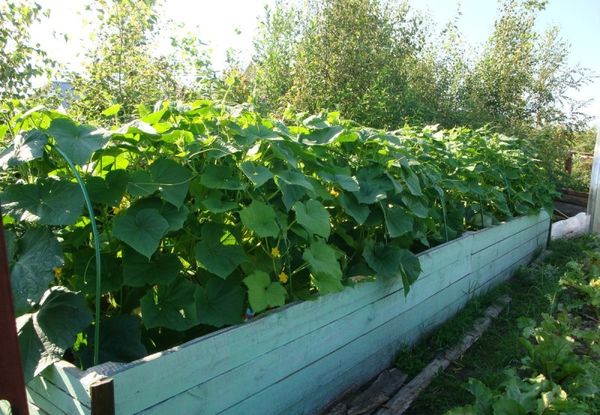
Landing
Landing perform in case of cloudy weather or in the eveningso that the sun rays do not dry the transplanted shoots. A few days before transplantation, seedlings need to be plentifully watered and fertilized with fertilizers. This will help her to quickly adapt to new conditions.
The holes in the plot are planned at such a distance from each other, so that the plants can comfortably grow and form whips. Each variety has a certain size of the stem, and they are taken into account when drawing up the scheme. Spray cucumbers are planted 5-6 plants per 1 m2, tall cultures - 3-4 shoots per 1 m2.
Into the prepared moistened well to bring a sapling together with land lump. To deepen the knee knee is not worth it. The surface of the soil is not strongly pressed down in order not to damage the sensitive processes of the roots.
The necessary care for seedlings after planting
Water temperature should not fall below 18 degrees. It is necessary to direct the stream on the soil between the rows, you should not spray the leaves. Before flowering, irrigation is carried out in moderation (1-2 times per week). The norms of the used liquid increase during the period of fruiting (from 1 l to 3 l).
It is recommended to hold several times per season. hilling. This procedure will allow a better formation of the root system, increase additional roots, which will make the plant more resistant to fungal diseases.
Loosening and weeding usually combined. During the season will require at least 3-4 procedures. Loosening enriches the soil with oxygen, prevents stagnant moisture. Weeding eliminates thickening of the landing, weeds attract insects, create shade, thanks to which spores and harmful microorganisms affecting cucumbers are activated.
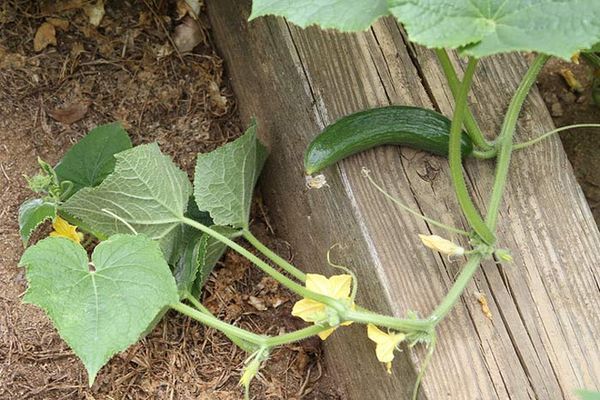
Caring for cucumber beds includes formation of a whip. This procedure is aimed at the development of lateral shoots, which produce a large number of female flowers. To do this, pinch the central stem over 5-6 leaflets.
Bushes need shaping mid-season and late varieties Zelentsov.Plants with an early maturing can not pinch.
What mineral and organic supplements can be applied
The fertilized bed with nutrients at the preparatory stage does not provide a developing escape with all the necessary microelements.
After germination spend root (1 time in 3 weeks) and foliar (weekly) top dressing. Organic and mineral fertilizers are used as food.
For foliar treatments used manure or poultry manure mortar. Root feeding include the use of the following tools:
- "Agricola 5 for cucumbers" - 1 tbsp. l on a bucket of water (3-4 liters per 1 m2);
- "Energen" - 2 capsules per bucket of water (3 liters per 1 m2);
- "Effecton-O" - 2 tbsp. l on a bucket of water (4 liters per 1 m2);
- "Agricola Vegeta" - 2 tbsp. l + nitrophoska 1 tbsp. l on a bucket of water (5 liters per 1 m2).
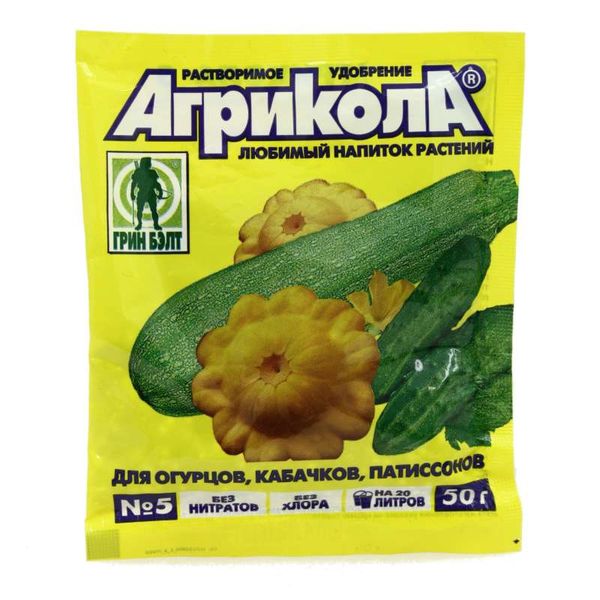
Errors
Among the main ones:
- using substandard seeds (there is poor germination of seed, the absence of ovaries);
- good soil filling before planting with fertilizers,which does not provide further feeding (this is a delusion, because the root system of cucumbers perceives food better from low concentration solutions, and an excess of trace elements negatively affects the growing season);
- growing seedlings of large size (you need to focus not on the size, but on the terms, they should not exceed 35 days);
- soil saturation nitrogen fertilizers (this leads to the rapid growth of foliage and reduces the formation of ovaries);
- irrigation use cold water (the plant develops slowly, practically does not bloom);
- the lack of methods of formation of the scourge (pinching and removal of lateral shoots are aimed at increasing the ovaries and ensuring sufficient nutrition for the entire plant).
Diseases, pests and good ways to fight
Even with proper care, cucumber beds are not protected from the onslaught of pests and diseases. Of course, the risk of damage to healthy well-groomed plants is small, but the danger exists. Therefore important instant reaction from gardeners when they find the first signs of a problem.
The following diseases are considered dangerous for the harvest.
- Mealy dew primarily affects the foliage, spreading further along the stems and petioles.Recognized by characteristic white spots. Treatment methods: removal from the bed and disposal of the affected bushes, treatment of cucumber with powdered sulfur (3 g per 1 m2), spraying with a solution of colloid sulfur (25 g. 0.3% sulfur per bucket of water).
- Perinosporosis (downy mildew) is manifested in the form of yellow-green spots with a light coating on the top of the bush. The disease is spreading rapidly, capable of destroying a whole bed in a short period of time. Treatment methods: spraying with a milky solution (1 l of milk and 10 drops of iodine in a bucket of water), treatment with bordeaux mixture.
- White rot affects all parts of the plant, forming mucus and light scurf. It is formed as a result of overmoistening, thickening of the landing and temperature drops. Transmitted through the soil and seeds. Control methods: regulation of irrigation, disinfection of the bed with a solution of water (10 l), copper sulphate (2 grams) and urea (10 grams). Affected bushes must be disposed of and replaced.
- Root rot recognized by the weak development of the plant and its withering, which occurs as a result of root decay. Causes may be covered in high humidity, temperature changes, contamination of the soil or seeds.Methods of control: regulation of irrigation, pruning of affected areas of the plant, dusting the soil with crushed lime (up to 200 grams per 1 m2).
- Mealy dew
- Perinosporosis
- White rot
No less dangerous for cucumbers are harmful insects:
- melon aphid (if it is found, spray it with a solution of ash at the rate of 200 g per 10 l of water + 50 g of rubbed soap, use Inta-Vir);
- spider mite (periodic spraying with infusions of onion peel or garlic will help);
- ants (powder the soil with lime, move the nest beyond the bed);
- slugs (device of traps for collecting pests, treatment with metaldehyde);
- whitefly (treatment with Inta-Vir).
Agrotechnics cucumbers, although it has some features, but quite feasible for any owner. If there is a desire to experiment, then the sample should be done on several bushes, and not on the whole bed. Then the next harvest will definitely be safe.
